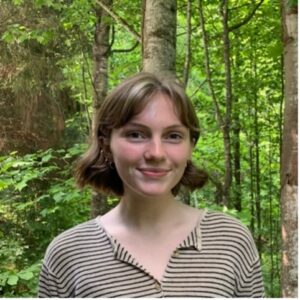
By Sarah Dean
Sarah Ellen Dean is a rising junior at UNC- Chapel Hill and an Environmental Studies and Studio Art student. She spent the 2023 spring semester at the Institute for the Environment’s Sustainable Triangle Field Site, located in Chapel Hill. Sarah Ellen is interested in the intersection of sustainability and design, particularly in green infrastructure and innovative problem solving to address climate hazards.
Seizing an Opportunity

I can’t tell you the exact date, but it was a cold, rainy morning in October and the last thing I wanted to do was get out of bed. My 9:00 a.m. environmental science class wasn’t sounding too enticing at the moment. However, I managed to muster the strength to get myself to class, and I am so glad I did.
That day, we had a guest speaker, Mike Piehler, come in to talk about the Sustainable Triangle Field Site, something I hadn’t heard of. After hearing about how I could take classes with a small cohort of other focused and driven students, conduct research, and learn about how to build a more sustainable future, all while staying in Chapel Hill, I knew I had to apply. Later that same day, I got started on my application and thanked myself for not skipping class. A few weeks later, I heard back and got some of the best news I’ve received in my time at Carolina.
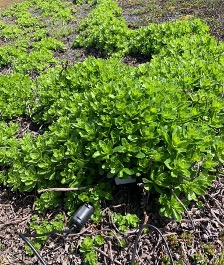
Learning Beyond a Traditional Classroom
During my time in the field site, I was immersed in a study of the environment, urban planning, and green urban design through a 15-credit hour course-load. With the 6 other students in my cohort, we undertook a group Capstone, Environmental Science Seminar, Complete Streets Seminar, and a Community Design and Green Architecture class. An additional perk to the program is that there’s built in space for participants to take an elective course. (I chose to knock BIOL 101 off my to-do list.)
Throughout the semester, our project felt ambitious at times. It was certainly the most frustrating part of my semester, but it was also the most inspiring and fulfilling. Through our research efforts and hands-on experience, I can confidently say I am a much stronger scientist, writer, and learner.
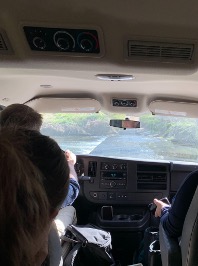
Although the program is led on-campus, most of our learning happened outside of a traditional classroom. We used the green infrastructure around us as our teachers. The FedEx Global Education Center’s green roofs and the Regenerative Stormwater Conveyance System at Battle Grove taught us so much more than a lecture could have. Furthermore, I’d be remiss if I didn’t acknowledge the phenomenal instruction and guidance from our mentors: Mike Piehler, Toni Sebastian, and Melanie Elliott. At every moment, their support and encouragement amazed me.
Working Together and Developing New Skills
The six women who started as my peers in the program became my close friends and confidants over the course of the semester. They were fellow scientists, insightful, witty, and downright funny. (We were never short of laughter during our group van rides!) I couldn’t have asked for a better group of girls to experience the program alongside. From getting boba to going to just about every Sustainable Carolina event together, my cohort felt like a family.
Together, we undertook a three-pronged research project where we investigated the impact of green infrastructure on UNC’s campus and used our findings to inform a design proposal for the upcoming Porthole Alley Project. Our first focus was on the extensive green roof on the FedEx Global Education Center. There, we compared green roof surface temperatures with traditional roof temperatures and collected soil moisture data on a variety of vegetation to compare water retention rates. During the research on the green roofs our class received great support from Krystal King, an employee at UNC, who not only maintains the green roofs but also was available several times on short notice to climb up to an inaccessible roof to assist with sensor placement.
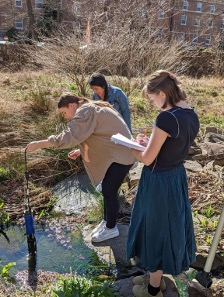
Our second focus was on the Regenerative Stormwater Conveyance System at Battle Grove. There, we collected nutrient data (dissolved oxygen, nitrate, phosphate, ammonium, & chlorophyll) and flow rate data. After data analysis, we used our findings to inform a design proposal for the Porthole Alley Project where we outlined plans for an extensive green roof with public space, and a water quality monitoring system.
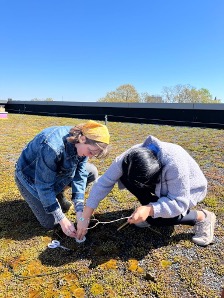
Throughout the semester, our project felt ambitious at times. It was certainly the most frustrating part of my semester, but it was also the most inspiring and fulfilling. Through our research efforts and hands-on experience, I can confidently say I am a much stronger scientist, writer, and learner.
With my time in the Sustainable Triangle Field Site at its end, I feel a great sense of pride and appreciation. I am so proud of the work that my cohort did, and I am grateful to have been a part of it. I can safely say that my experience is one I’ll cherish for a lifetime. I’m leaving the program with an understanding of complex environmental systems, an appreciation for all researchers, a bunch of photos of green roof sedums, and several new friends.
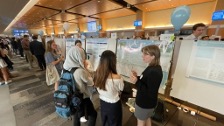
To learn more about the Institute for the Environment semester long field sites visit: https://ie.unc.edu/education/field-sites/

